|
Say you sit down in front of a mainstream action crime thriller without realising that it was made in America in the 1980s. How long is it before you know this for sure? In the case of To Live and Die in L.A., it took me about 10 seconds. Yes, I'd seen it before, but I also had some serious help from Wang Chung's score, the sort of beat-driven, loudly in-your-face synth track that remains largely exclusive to that continent and that decade. The film then trots through a handful of cop drama clichés that there's a good chance it helped to define as such in the first place. We're introduced to the most prominent purveyor of these – middle-aged Secret Serviceman Jimmy Hart – when he tackles a Muslim suicide bomber ("I am a martyr!") by tossing him off a roof, survives the subsequent explosion with only a pulled shoulder, then sits down with his younger partner Richard Chance and wearily tells him, "I'm getting too old for this shit." Aren't we all. We then learn that he's just three days from retirement. Uh-oh, that's never a good sign. Before handing in his badge he nips off on his own to do a little poking around at the isolated warehouse in which ruthless forger Eric Masters does his business. You shouldn't need three guesses to work out what happens to him there. After they find his body, Chance even gets to verbally mourn the fact that he had just two days left on the job. It's safe to say that some elements of To Live and Die in L.A. have not aged that well.
Yet early on we also get a taste of what continues to make it one of the more distinctive crime thrillers to emerge from the 1980s, as Masters prepares and prints his forged banknotes in a fascinating montage that may not be one hundred per cent accurate (then again, considering the film had a former counterfeiter on staff as an advisor, who knows?), but certainly looks very much for real. It's this operation that Hart gets too close to and ends up being executed for poking his investigative nose into. Chance takes it personally ("he was more than my partner, he was my best friend") and becomes even more determined to take Masters down. And he doesn't care what rules he may have to break to do it. This is something he makes clear to Agent John Vukovich when he proposes that he become Chance's new partner. Quite why he is so keen to do so is uncertain, but it quickly becomes clear is that he has no idea what he's let himself in for.
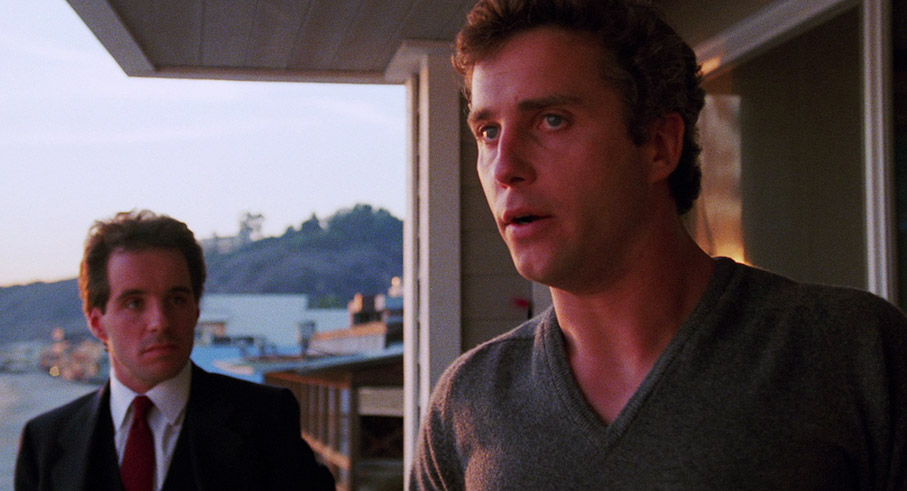
Initially the two men are shown to be in sync when they track down one of Masters' delivery men – a fellow named Cody, who's not interested in going quietly – and pursue him through an airport in a thrillingly shot sequence that gives a small taste of a considerably more elaborate chase scene to come. A short while later they're even chatting like old buddies while on overnight stakeout, one they bungle by falling asleep on the job and waking too late to stop Masters killing the very man they were using as bait to entrap him. Vukovich is outraged when Chance takes a notebook that might help him from the crime scene, but it's when Chance proposes robbing a criminal courier in order to get the cash they need for a fake deal with Masters that he becomes aware that they are crossing a very dangerous line.
Two years down the line, Lethal Weapon would have us bonding with a risk-taking and emotionally unstable police detective, in the process kicking off a string of buddy cop movies in which mismatched partners were the source of incident and character merriment. In To Live and Die in L.A., director William Friedkin takes a different tack and invites us to engage instead with a man who is morally suspect and not particularly likable. Whether we're supposed to see him as such is difficult to gauge, but if you don't warm to him – and I never really did – then you'll be looking to Vukovich as your point of engagement, and I didn't get to know him well enough for this to happen either. It probably doesn't help that Rick Masters has dark charisma dripping from every pore, and although he is even more morally vacant than Chance, I found it easier to warm to his cool malevolence than Chance's angry intensity. Intriguingly, there are alternate scenes when we are encouraged to root for both men and get behind them whether we like them or not. In the Los Angeles of Friedkin's film, the line between criminals and law enforcement agents is one you'd probably need a degree in quantum science to prove the existence of.
In some ways Chance conforms to the American film detective norm. He gets key information from a reliable snitch, breaks rules to get results, and is relentless in his pursuit of a bad guy who is also his nemesis. Yet he pushes each of these traits a few notches beyond the norm. His snitch is a girl with whom he also sleeps when he so pleases and whom he keeps in line by threatening to revoke her parole, while his obsessive determination to bring Masters down transforms him from a rule-breaker into a reckless criminal, one whose actions have consequences even he can't predict but which he refuses to take responsibility for. It's established early on that he's an adrenaline junkie who gets a serious rush from putting his own life in danger, and increasingly this becomes his modus operandi, whatever the potential cost to others.
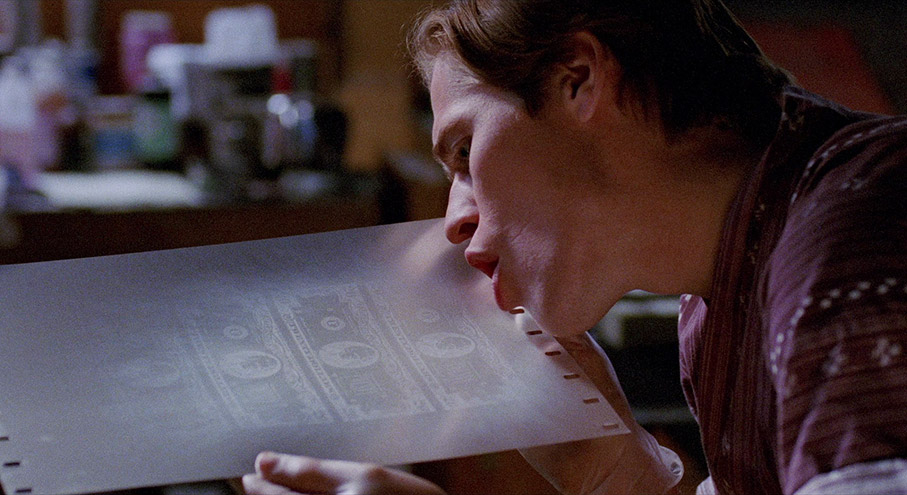
Looking to make an independent rather than studio action thriller, Friedkin was keen to sidestep the baggage that comes with known faces by peppering the cast with relative unknowns, and in the process assembled an impressive roster of now instantly recognisable performers. At this point in his film career, William Petersen had only had a single blink-and-you'll miss-it role in Michael Mann's debut feature Thief to his name, and was still a year away from his pitch-perfect performance as Investigator Will Graham in Mann's superb Manhunter. The intensity he brought to that role is visible here in spades in his portrayal of Chance, but stripped of the vulnerable sensitivity that so humanised Graham – Chance is someone you stand back and watch slowly self-destruct rather than get to know or like, an aspect that Petersen absolutely has nailed. As the initially eager Vukovich, John Pankow certainly makes for a convincing enforcement officer, but really comes into his own when the results of his partner's actions trigger a string of increasingly strong emotional meltdowns. But quietly stealing the show as Masters is Willem Dafoe, whose angular features, sardonic smile, calm air of authority and cool delivery suggest with every word and look that he is a man who has the power to make just about anything happen. But that's not all. Impressively low-key as Masters' lawyer Bob Grimes is the lovely Dean Stockwell, and already showing the sort of wide-eyed volatility that he would later make his own as Cody is John Turturro, still four years away at this point from his first career-changing collaboration with Spike Lee. Holding their own as Chance's informant Ruth and Masters' girlfriend Bianca, meanwhile, are Darlanne Fleugel and Debra Feuer, both of whom make an impression in what in other hands could have been thankless or even purely decorative roles.
The showpiece scene, as anyone who has seen the film will know, is the car chase that ensues when Chance and Vukovich are forced to flee from the scene of their messed-up courier robbery, as they are relentlessly pursued by a small army of the man's protectors. Friedkin apparently wanted to stage a chase that would outdo his own benchmark one in The French Connection – it doesn't (how could it?), but it's still a belter, a hectic high-speed weave through industrial alleyways and the city's landmark open storm drains, which is then topped by a heart-pounding plummet into oncoming traffic on a busy freeway. Characteristically, this death-defying misadventure leaves Chance whooping with glee and Vukovich reduced to a blubbering wreck.

Physical combat is impressively messy, much as it would probably be in real life (and everyone is shown to be vulnerable here, Masters included), and some of the killings deliver a genuine jolt. But they also highlight a small thread of artificiality that runs throughout the film. While the gunshots are shocking – three are to the face and come out of nowhere – all are staged by spraying the victim's face or body with a blast of red liquid, suggesting that instead of being pierced with bullets or shotgun pellets they've been hit with a lethal gel. And then there are the names given to three of the characters. While we can presumably lay this at the feet of co-screenwriter and author of the source novel, Gerald Petievich, I can't be the only one who raised an eyebrow at the decision to name the lead character Chance (he likes to take chances), the bad guy Masters (he's a master forger), and a lawyer who is on Masters' criminal payroll Grimes (well, he is dirty). And those who can catch a breath during the against-traffic chase will doubtless notice that the cars are driving on the left side of the road, which would be fine if this were ‘To Live and Die in Scunthorpe', but arse about face for a Los Angeles freeway. This particular mystery is cleared up on this disc's special features, when it's revealed that Friedkin chose to reverse the direction of the traffic in order to get a more interesting background for his chase.
I remember not being that keen on To Live and Die in L.A. when I saw it on its initial cinema release, and my first viewing of this disc also left me feeling a little unsure how I felt about it. But I gave it a few days, gave the special features a look and returned to the film and got a hell of a lot more out of it the third time around. Tonally, it's one of the darkest crime thrillers of the period, painting a sobering picture of a world in which crime is like a contagious disease that corrupts and ultimately destroys anybody it touches, irrespective of which side of the law they reside on. Friedkin's direction is consistently assured and moves into urgent overdrive when his characters get on the move, and a couple of the second half twists deliver real gut punches. Master cinematographer and Wim Wenders regular Robby Müller also has a real eye for capturing Los Angeles on film like it's never been seen before, painting it as a visually striking but unappealing location that feels as if it's being forever pulled towards twilight and where interiors are swathed in expressionistic shadow or coloured light. Whether the score delights or annoys you will be very much down to personal taste (it definitely has drive, but for me it gives the film a Miami Vice coating that it has no need of), and if you like your heroes clean-cut and morally sound then the film as a whole may well prove to be the sort of downer you don't need in these troubled times. But if you prefer your crime thrillers edgy, downbeat, violent, unpredictable and unwaveringly cynical, and your lead characters flawed and wilfully self-destructive, then The Live and Die in L.A. should be right up your street. It stands out now as one of Friedkin's best post-Sorcerer films, and in its refusal to provide upbeat character arcs or a comfortable conclusion, it feels disarmingly modern.
The Blu-ray in this dual format set boasts a delicious 1.85:1 1080p transfer that flatters Robby Müller's moodily vibrant cinematography. The colours are rich without feeling over-saturated, the sharpness and level of detail strong and the contrast balance nicely pitched, particularly in the daylight but also coping well with the shadowed and coloured interiors. The golden hour imagery – of which there is a good deal – is particularly lush. The image is also free of damage and spots.
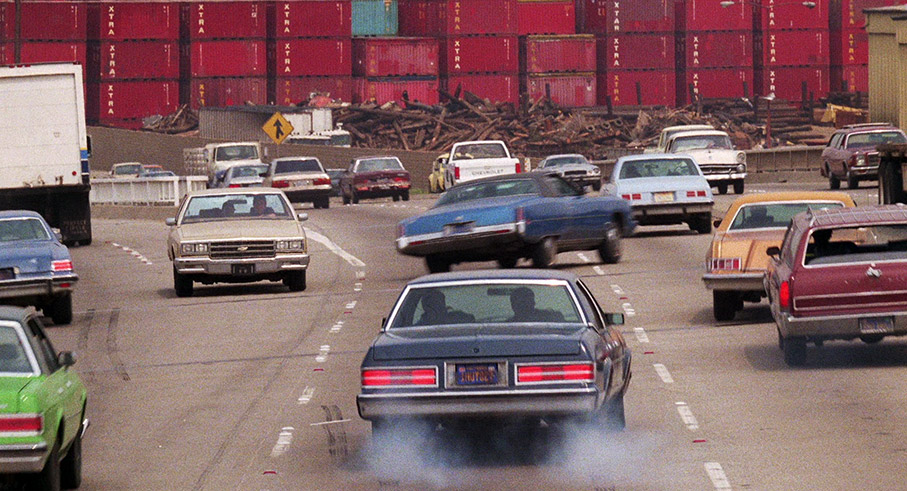
The Linear PCM stereo track is in excellent shape, having a lively dynamic range that really hits you when the music kicks in. The dialogue is clear, the sound effects are crisp and the stereo separation distinct. Nice job.
Optional English subtitles for the deaf and hearing impaired are also available.
Taking a Chance (20:41)
An interview with lead actor William Peterson, who now looks and sounds more like Richard Dreyfuss's cousin than the intense and wirily muscular actor we know from Manhunter and To Live and Die in L.A.. An enthusiastic and engaging interviewee, Petersen goes into some detail about how he landed the part and recalls working with Friedkin (who sometimes shot and printed what the actors were under the impression was a rehearsal), how they circumnavigated imposed restrictions on what they could do during the airport chase, how much he enjoyed doing the high speed driving when allowed to do so, and more. He also talks about the alternative ending that the producers insisted they film but which was ultimately not used, so avoid watching this one before the main feature. Actually, that goes for all the extra features here.
Doctor for a Day (8:52)
Actor Dwyer Brown, who has a very small role as a doctor in the film, recalls his audition, his single day of filming and meeting Friedkin again later on a different project, by when the director had forgotten they ever worked together.
Renaissance Woman in L.A. (14:55)
Actress Deborah Feuer, who plays Masters' girlfriend Bianca, recalls landing the role, the instant chemistry she had with Willem Dafoe ("a fascinating, intelligent, sexy guy"), using her own clothes in the film after Friedkin liked what she was wearing when she turned up each day, the "fluid sexuality" of her character, and more.
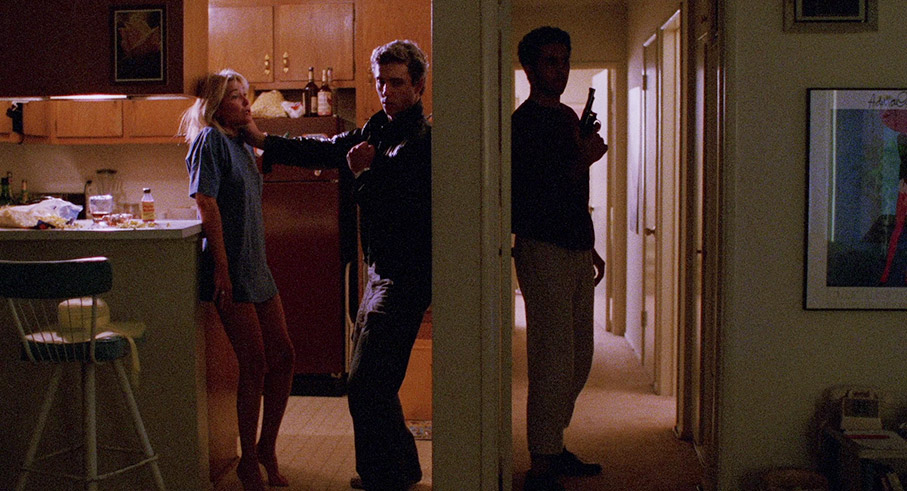
So in Phase: Scoring To Live and Die in L.A. (12:43)
Jack Hues and Nick Feldman of Wang Chung (I had to look this up, as neither are captioned and are two of four names thanked in the closing credits), recall being offered their first film score after getting a call from Friedkin, who had temp tracked a sequence with their earlier song Wait. Instead of specifically scoring scenes in the usual manner, they were asked by him instead to "Go to the studio and be brilliant," and then Friedkin and editor Scott Smith fitted what they created to the film. They reveal that Friedkin didn't want a song titled To Live and Die in L.A. but that they recorded one anyway and liked it so much he restructured the opening sequence around it, and there's an amusing story about the director breaking off from telling them a cheerful anecdote to ball someone out, then switching back to normal as if nothing had happened. This brought back some memories – the very same thing happened to me when I was chatting to a film industry figure many years ago.
Wrong Way: The Stunts (35:38)
An interview with stunt coordinator Buddy Joe Hooker, who usefully outlines what his job entailed in pre-CG days (yep, that's changed everything), how he got involved in the film, and what it was like working with Friedkin ("one of the best action directors ever"). Unsurprisingly, the lion's share of the interview is focussed on prepping and executing the freeway chase, which he believes outstrips the chases in both The French Connection and Bullitt (disagree!), and he even has one of the diagrams that he prepared to plan out the chase and the various collisions and misses. Cool. He also reveals that there wasn't a single injury sustained during the shooting of the action sequences, which is pretty impressive.
Counterfeit World (29:41)
Framed 4:3, which suggests that this was sourced from an early DVD release, this retrospective, making-of documentary is bog standard in structure, but is nonetheless bristling with interesting interviews and includes some welcome behind-the scenes footage. William Friedkin talks about the film's portrait of a counterfeit world, his preference for spontaneity and working quickly, and what drew him to the project. William Peterson describes his character as one who is above not just the law and but also life and death, at least in his own head. John Pankow praises Friedkin's direction of his actors and recalls meeting an undercover cop who praised his portrayal of on-the-job panic as on the nose. Willem Dafoe reveals the ways Friedkin pushed him better understand his character and says that as a director he creates the ingredients for a scene and then relies on the actors to make something happen. Darlanne Fluegel recalls being taken with Wiliam Petersen by Friedkin to the house in which they would be filming and then left there to work on their characters and their screen relationship together. And this is just a sample. We get the full story on how they shot the bit of the airport chase that they were informed that they weren't allowed to do (this is a good story), but the most intriguing tale revolves around their printing of the counterfeit money and how it landed prop master Barry Bedig a number of late night visits from Treasury officials.
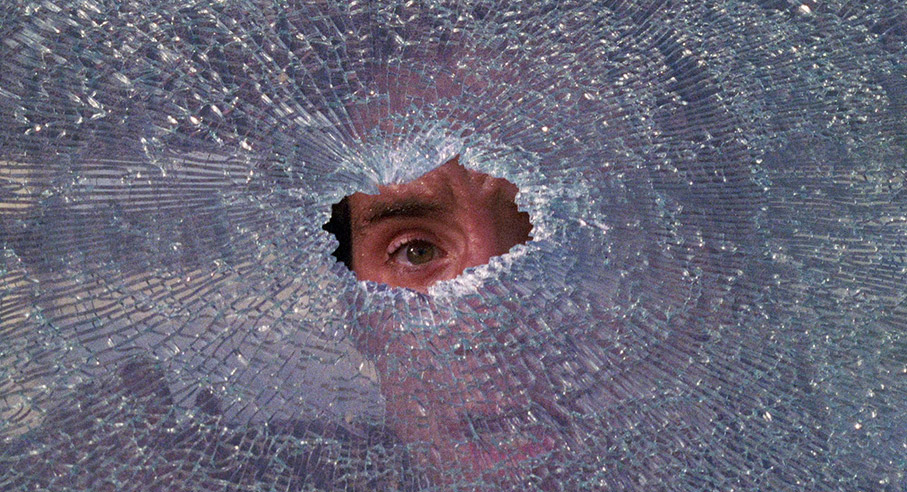
Alternative Ending (5:59)
The alternative ending requested by the producers, complete with end credits superimposed over a final helicopter shot. Definitely one to watch after you've seen the film, and then you'll understand why Friedkin refused to use it. You can also play this with an Introduction (2:19), which has contributions from William Friedken, William Peterson, John Pankow and co-producer Bud Smith (who's also credited here as the editor, but the film itself credits his son Scott with the job), and their comments tell a story. Friedkin describes this ending as "terrible," Petersen claims that it would have been "the Eddie Murphy version of To Live and Die in L.A.," and Bud Smith recalls screening the film for Friedkin with the new ending added and Friedkin responding, "Get rid of that shit."
Deleted Scene (2:04)
A sequence that is discussed elsewhere in the extras and that only appears to exist now on 3rd-generation VHS. It's still a useful grab, offering a glimpse into Vukovich's own personal troubles as he pays a confrontational visit to his ex-wife. This can also be played with an Introduction (1:51), in which Friedkin praises the scene and wonders why the hell he cut it.
Stills & Photo Gallery
A manually advanced collection of production photos, behind-the-scenes stills and press materials, 124 of them in total.
Trailers (3:32)
Two promotional trailers, one caption driven, the other fronted by the more traditional deep voiced narration that really pushes the film as a high-octane thriller. I preferred the first one.
Radio Spot (1:04)
A serious voiced audio sell that tells you a big fat lie about the fate of the characters.
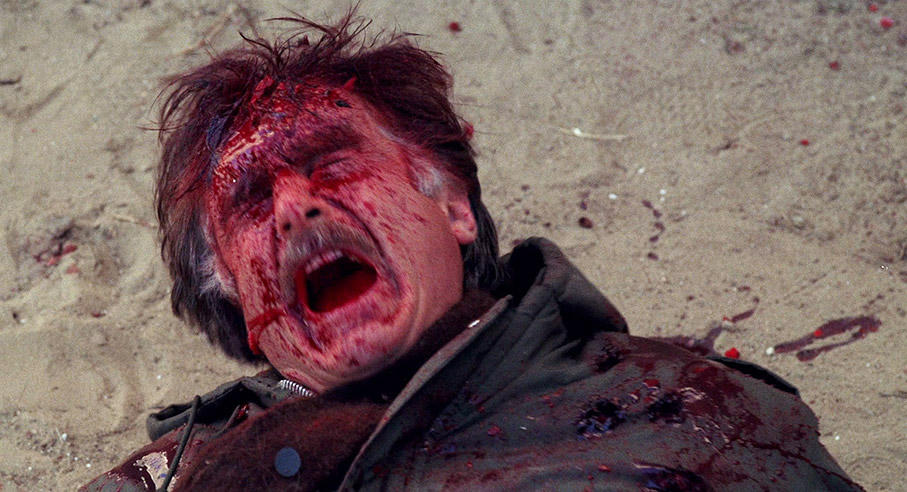
Commentary
This commentary by director William Friedkin, very probably recorded for an earlier DVD release, is a gem of an extra, despite a small amount of duplication with the other special features in this set. Although Friedkin was not watching the film when this was recorded, it has been edited to ensure that his comments usually relate directly to what's unfolding on screen. Friedkin is a fine and passionate raconteur and he covers a lot of ground here, including how the project began, selecting the actors, working with author Gerald Petievich on the screenplay, the main title sequence, his discovery and use of the Louma crane, and a whole load more. He covers the story of how their printed money attracted the attention of the Treasury Department in a lot more detail than in the documentary, has some interesting stories of how he worked with the cast members (a favourite instruction to Willem Dafoe was, "Zen"), and explains his pragmatic reason for the blood spray effect when people get shot. I was intrigued to learn that he wanted the main chase to be Kafka-esque, an instruction he jokingly claims sent stunt coordinator Buddy Joe Hooker scurrying to the library.
The first pressing also contains a collector's booklet featuring new writing on the film by Anne Billson, but we've not seen this.
It's always nice when a film grows on you with repeated viewings, and that certainly happened for me with To Live and Die in L.A.. It's a tough and sometimes discomforting thriller with a belter of a cast and one of the best car chases in modern American cinema, gorgeously shot and only really tied to its time by the score and Agent Jimmy Hart being too old for this shit and being killed when he was just three days from retirement. Arrow has once again done the film proud, with an excellent transfer and a comprehensive collection of quality extras. Recommended.
|